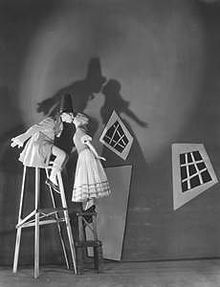The avant-garde (/ˌævɒ̃ˈɡɑːrd/; In French: [avɑ̃ɡaʁd] 'advance guard' or 'vanguard', literally 'fore-guard') is a person or work that is experimental, radical, or unorthodox with respect to art, culture, or society. It is frequently characterized by aesthetic innovation and initial unacceptability.
The avant-garde pushes the boundaries of what is accepted as the norm or the status quo, primarily in the cultural realm. The avant-garde is considered by some to be a hallmark of modernism. Many artists have aligned themselves with the avant-garde movement, and still continue to do so, tracing their history from Dada through the Situationists and to postmodern artists such as the Language poets around 1981.
The avant-garde also promotes radical social reforms. This meaning was evoked by the Saint Simonian Olinde Rodrigues in his essay, "L'artiste, le savant et l'industriel" ("The artist, the scientist and the industrialist", 1825). This essay contains the first use of "avant-garde" in its now customary sense; there, Rodrigues called on artists to "serve as [the people's] avant-garde", insisting that "the power of the arts is indeed the most immediate and fastest way" to social, political and economic reform.
History
The term was originally used by the French military to refer to a small reconnaissance group that scouted ahead of the main force. It also became associated with left-wing French radicals in the 19th century who were agitating for political reform. At some point in the middle of that century, the term was linked to art through the idea that art is an instrument for social change. Only toward the end of the century did l'art d'avant-garde begin to break away from its identification with left-wing social causes to become more aligned with cultural and artistic issues. This trend toward increased emphasis on aesthetic issues has continued to the present. Avant-garde today generally refers to groups of intellectuals, writers, and artists, including architects, who voice ideas and experiment with artistic approaches that challenge current cultural values. Avant-garde ideas, especially if they embrace social issues, often are gradually assimilated by the societies they confront. The radicals of yesterday become mainstream, creating the environment for a new generation of radicals to emerge.
Theories
Several writers have attempted to map the parameters of avant-garde activity. Italian essayist Renato Poggioli provides one of the earliest analyses of vanguardism as a cultural phenomenon in his 1962 book, Teoria dell'arte d'avanguardia (The Theory of the Avant-Garde). Surveying the historical, social, psychological and philosophical aspects of vanguardism, Poggioli reaches beyond individual instances of art, poetry, and music to show that vanguardists may share certain ideals or values, which manifest themselves in the non-conformist lifestyles they adopt. He sees vanguard culture as a variety or subcategory of Bohemianism. Other authors have attempted both to clarify and to extend Poggioli's study. The German literary critic Peter Bürger's Theory of the Avant-Garde (1974) looks at the Establishment's embrace of socially critical works of art, and suggests that in complicity with capitalism, "art as an institution neutralizes the political content of the individual work."
Raymond Williams devotes two chapters of his book, The Politics of Modernism(1989), to a discussion of the politics and language of the avant-garde.
Bürger's essay also greatly influenced the work of contemporary American art historians such as the German Benjamin H. D. Buchloh (born 1941). Buchloh, in the collection of essays Neo-avantgarde and Culture Industry (2000), critically argues for a dialectical approach to these positions. Subsequent criticism theorized the limitations of these approaches, noting their circumscribed areas of analysis, including Eurocentric, chauvinist, and genre-specific definitions.
Relation to mainstream society
The concept of avant-garde refers primarily to artists, writers, composers, and thinkers whose work is opposed to mainstream cultural values, and often has a trenchant social or political edge. Many writers, critics, and theorists made assertions about vanguard culture during the formative years of modernism, although the initial definitive statement on the avant-garde was the essay "Avant-Garde and Kitsch", by New York art critic Clement Greenberg. It was published in Partisan Review in 1939. Greenberg argued that vanguard culture has historically been opposed to "high" or "mainstream" culture, and that it has also rejected the artificially synthesized mass culture that has been produced by industrialization. Each of these media is a direct product of capitalism—they are all now substantial industries—and as such, they are driven by the same profit-fixated motives of other sectors of manufacturing, not the ideals of true art. For Greenberg, these forms were therefore kitsch - phony, faked, or mechanical culture. Such things often pretended to be more than they were by using formal devices stolen from vanguard culture. For instance, during the 1930s, the advertising industry was quick to take visual mannerisms from surrealism, but this does not mean that 1930s advertising photographs are truly surreal.
Similar views were argued by members of the Frankfurt School, the originators of Critical Theory, an approach to social philosophy that focuses on reflective assessment and critique of society and culture in order to reveal and challenge power structures. Theodor Adorno and Max Horkheimer in their essay "The Culture Industry: Enlightenment as Mass-Deception" (1944), and also Walter Benjamin in his highly influential "The Work of Art in the Age of Mechanical Reproduction" (1935, rev. 1939) spoke of "mass culture." They indicated that this bogus culture is constantly being manufactured by a newly emerged culture industry (comprising commercial publishing houses, the movie industry, the record industry, and the electronic media). They also pointed out that the rise of this industry meant that artistic excellence was displaced by sales figures as a measure of worth: a novel, for example, was judged meritorious solely on whether it became a best-seller; music succumbed to ratings charts, and to the blunt commercial logic of the Gold disc. In this way, the autonomous artistic merit, so dear to the vanguardist, was abandoned and sales increasingly became the measure, and justification, of everything. Consumer culture now ruled.
The avant-garde's co-option by the global capitalist market, by neoliberal economies, and by what Guy Debord called The Society of the Spectacle (a seminal text for the Situationist movement describing the "autocratic reign of the market economy"), have made contemporary critics speculate on the possibility of a meaningful avant-garde today. Paul Mann's Theory-Death of the Avant-Garde demonstrates how completely the avant-garde is embedded within institutional structures today, a thought also pursued by Richard Schechner in his analyses of avant-garde performance.
Despite the central arguments of Greenberg, Adorno, and others, various sectors of the mainstream culture industry have co-opted and misapplied the term "avant-garde" since the 1960s, chiefly as a marketing tool to publicise popular music and commercial cinema. It has become common to describe successful rock musicians and celebrated film-makers as "avant-garde", the very word having been stripped of its proper meaning. Noting this important conceptual shift, major contemporary theorists such as Matei Calinescu in Five Faces of Modernity: Modernism, Avant-garde, Decadence, Kitsch, Postmodernism (1987), and Hans Bertens in The Idea of the Postmodern: A History (1995), have suggested that this is a sign our culture has entered a new post-modern age, when the former modernist ways of thinking and behaving have been rendered redundant.
Nevertheless, an incisive critique of vanguardism as against the views of mainstream society was offered by the New York critic Harold Rosenberg in the late 1960s. Trying to strike a balance between the insights of Renato Poggioli and the claims of Clement Greenberg, Rosenberg suggested that, from the mid-1960s onward, progressive culture ceased to fulfill its former adversarial role. Since then it has been flanked by what he called "avant-garde ghosts to the one side, and a changing mass culture on the other", both of which it interacts with to varying degrees. This has seen culture become, in his words, "a profession one of whose aspects is the pretense of overthrowing it."
Avant-garde is frequently defined in contrast to arrière-garde, which in its original military sense refers to a rearguard force that protects the advance-guard. The term was less frequently used than "avant-garde" in 20th-century art criticism. The art historians Natalie Adamson and Toby Norris argue that arrière-garde is not reducible to a kitsch style or reactionary orientation, but can instead be used to refer to artists who engage with the legacy of the avant-garde while maintaining an awareness that doing so is in some sense anachronistic. The critic Charles Altieri argues that avant-garde and arrière-garde are interdependent: "where there is an avant-garde, there must be an arrière-garde."
Examples
Music
Avant-garde in music can refer to any form of music working within traditional structures while seeking to breach boundaries in some manner. The term is used loosely to describe the work of any musicians who radically depart from tradition altogether. By this definition, some avant-garde composers of the 20th century include Arnold Schoenberg, Richard Strauss (in his earliest work), Charles Ives, Igor Stravinsky, Anton Webern, Edgard Varèse, Alban Berg, George Antheil (in his earliest works only), Henry Cowell (in his earliest works), Harry Partch, John Cage, Iannis Xenakis, Morton Feldman, Karlheinz Stockhausen, Pauline Oliveros, Philip Glass, Meredith Monk, Laurie Anderson, and Diamanda Galás.
There is another definition of "Avant-gardism" that distinguishes it from "modernism": Peter Bürger, for example, says avant-gardism rejects the "institution of art" and challenges social and artistic values, and so necessarily involves political, social, and cultural factors. According to the composer and musicologist Larry Sitsky, modernist composers from the early 20th century who do not qualify as avant-gardists include Arnold Schoenberg, Anton Webern, and Igor Stravinsky; later modernist composers who do not fall into the category of avant-gardists include Elliott Carter, Milton Babbitt, György Ligeti, Witold Lutosławski, and Luciano Berio, since "their modernism was not conceived for the purpose of goading an audience."
The 1960s saw a wave of free and avant-garde music in jazz genre, embodied by artists such as Ornette Coleman, Sun Ra, Albert Ayler, Archie Shepp, John Coltrane and Miles Davis. In the rock music of the 1970s, the "art" descriptor was generally understood to mean "aggressively avant-garde" or "pretentiously progressive". Post-punk artists from the late 1970s rejected traditional rock sensibilities in favor of an avant-garde aesthetic.
Theatre
Whereas the avant-garde has a significant history in 20th-century music, it is more pronounced in theatre and performance art, and often in conjunction with music and sound design innovations, as well as developments in visual media design. There are movements in theatre history that are characterized by their contributions to the avant-garde traditions in both the United States and Europe. Among these are Fluxus, Happenings, and Neo-Dada.



